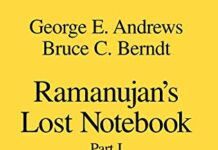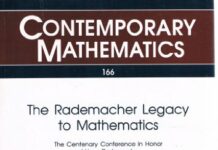
Ebook Info
- Published: 1994
- Number of pages: 288 pages
- Format: PDF
- File Size: 12.15 MB
- Authors: George E. Andrews
Description
Written by a distinguished mathematician and teacher, this undergraduate text uses a combinatorial approach to accommodate both math majors and liberal arts students. In addition to covering the basics of number theory, it offers an outstanding introduction to partitions, plus chapters on multiplicativity-divisibility, quadratic congruences, additivity, and more. Although mathematics majors are usually conversant with number theory by the time they have completed a course in abstract algebra, other undergraduates, especially those in education and the liberal arts, often need a more basic introduction to the topic. In this book, the author solves the problem of maintaining the interest of students at both levels by offering a combinatorial approach to elementary number theory. Among the topics covered in this accessible, carefully designed introduction are:Multiplicativity-divisibility, including the fundamental theorem of arithmeticCombinatorial and computational number theoryCongruences, arithmetic functions, primitive roots and prime numbersLater chapters offer lucid treatments of quadratic congruences, additivity (including partition theory), and geometric number theory Of particular importance in this text is the author’s emphasis on the value of numerical examples in number theory and the role of computers in obtaining such examples. Exercises provide opportunities for constructing numerical tables with or without a computer. Students can then derive conjectures from such numerical tables, after which relevant theorems will seem natural and well-motivated. Dover is widely recognized for a magnificent mathematics list featuring such world-class theorists as Paul J. Cohen (Set Theory and the Continuum Hypothesis), Alfred Tarski (Undecidable Theories), Gary Chartrand (Introductory Graph Theory), Hermann Weyl (The Concept of a Riemann Surface), Shlomo Sternberg (Dynamical Systems), and multiple works by C. R. Wylie in geometry, plus Stanley J. Farlow’s Partial Differential Equations for Scientists and Engineers.
User’s Reviews
Editorial Reviews: About the Author The Holy Grail of Number Theory George E. Andrews, Evan Pugh Professor of Mathematics at Pennsylvania State University, author of the well-established text Number Theory (first published by Saunders in 1971 and reprinted by Dover in 1994), has led an active career discovering fascinating phenomena in his chosen field — number theory. Perhaps his greatest discovery, however, was not solely one in the intellectual realm but in the physical world as well. In 1975, on a visit to Trinity College in Cambridge to study the papers of the late mathematician George N. Watson, Andrews found what turned out to be one of the actual Holy Grails of number theory, the document that became known as the “Lost Notebook” of the great Indian mathematician Srinivasa Ramanujan. It happened that the previously unknown notebook thus discovered included an immense amount of Ramanujan’s original work bearing on one of Andrews’ main mathematical preoccupations — mock theta functions. Collaborating with colleague Bruce C. Berndt of the University of Illinois at Urbana-Champaign, Andrews has since published the first two of a planned three-volume sequence based on Ramanujan’s Lost Notebook, and will see the project completed with the appearance of the third volume in the next few years. In the Author’s Own Words: “It seems to me that there’s this grand mathematical world out there, and I am wandering through it and discovering fascinating phenomena that often totally surprise me. I do not think of mathematics as invented but rather discovered.” — George E. Andrews
Reviews from Amazon users which were colected at the time this book was published on the website:
⭐A few years ago, I read this book by George Andrews of Penn State University into chapter 8 and this 1971 textbook by him already shows his long interest in both combinatorics and number theory. Where I stopped reading was when the author’s proofs started being multiple pages long.Here are the titles of the chapters with their starting pages:// PART I Multiplicativity-Divisibility // 1. Basis Representation-3 / 2. The Fundamental Theorem of Arithmetic-12 / 3. Combinatorial and Computational Number Theory-30 / 4. Fundamentals of Congruences-49 / 5. Solving Congruences-58 / 6. Arithmetic Functions-75 / 7. Primitive Roots-93 / 8. Prime Numbers-100 // PART II Quadratic Congruences // 9. Quadratic Residues-115 / 10. Distribution of Quadratic Residues-128 // PART III Additivity // 11. Sums of Squares-141 / 12. Elementary Partition Theory-149 / 13. Partition Generating Functions-160 / 14. Partition Identities-175 // PART IV Geometric Number Theory // 15. Lattice Points-201 / There are four mathematical appendices and the full set of indices after the 15 chapters–213-259.From the complicated table of contents above, one can see a broad sweep of combinatorial number theory. Part I is mostly pretty straight number theory, and that is what I did read. Part III on additivity is almost fully combinatorics more than number theory though. Still the price of this book is quite low to have access to all of this big range of mathematics to pick and choose what is most interesting to any given reader. Recommended.
⭐As a retired statistician and teacher, I never had the opportunity to formally study number theory. Over the years I was exposed to the topic and learned some of the basics — sort of the tip of the iceberg. I learned enough to want to know more; hence, the acquisition of this book. I am quite familiar with Dover Publications and a big fan of their libary. Dover typically publishes comprehensive texts at reasonable prices. So when I was looking for a book on this subject and saw this one, I decided to buy it.I am glad I did. I am working my way through it — problems and all — and have finished the first three chapters. I find the material well presented and satisfying my needs. As a statistician I appreciate the fact that Dr. Andrews elected to take a combinatorial approach to the topic. Being familiar with this type of reasoning makes certain topics easier for me to comprehend. The book is not for the layman and takes an individual with a solid mathematical background to get through it in its entirety. However, if you’re interested in the topic and willing to put in the effort, the book will pay off.
⭐My gift was well received; however, where might I find a solutions manual? Thank you.
⭐I had a number theory class back in the dark ages when i was studying Mathematics at OSU. Before I started this book I reviewed another number theory book. It was like deja vu – the method was exactly what I had seen before. In fact, it may have been the same book. Then I picked this up to go a little more in depth. I was a little thrown off at first. Pretty much the same things were covered but from such a vastly different angle it almost seemed like a whole different field of mathematics.I can’t say which viewpoint is the correct one (they both are, I guess) but, since the books are so inexpensive, I would suggest try each or using both. It is often eye-opening to see the same conclusion derived from attacking the problem from more than one angle.
⭐Number theory is both easy and difficult. This book does a good job of highlighting some of these aspects in a clear and straightforward way. It also does a good job of discussing the role technology is playing for some in the field today.
⭐George Andrews is the reigning expert on partitions in the mathematical community who has written many seminal papers on the subject over the past half-century! If you don’t know what partitions are in the theoretical sense, don’t worry, the text provides ample introduction. I don’t think you can find a more elementary introduction to the difficult, but extraordinarily powerful and elegant theory of partitions. The book covers the basics of number theory well, but it is the chapters on partitions that make this text stand out. It covers the Rogers-Ramanujan identities as well as the Jacobi triple product identity. It is rare in the mathematical community that an expert in a subject also writes a ground-level introductory text – but that’s what you have here. Thanks to the dover edition, it’s now quite affordable.
⭐You simply can not beat the content for the price!One huge complaint though for the Kindle Edition. On the big iPad Pro, some formulas are just about unreadable. The formulas appear to be images and their size can not be adjusted with the text size adjustment. The resolution on these formula image is so poor that some of the small parts of the formula, like subscripts and superscripts are simply unreadable. I’ve taken to trying to use a magnifying glass to help read some formulas, but that is simply not an enjoyable reading experience.
⭐The presentation is consistent and if you don’t fight it, brings back pleasant memories. I remember being afraid of the notation, did I really understand it? There are multiple levels of abstraction to deal with. They pop up at odd times during a reading. Keep going until no new meanings jump out at you, then put it down, wait awhile and read it again. It’s nice not to worry about an examination or presentation of the material.
⭐Very interesting introduction to number theory. The book starts by introducing Peano’s axioms, as well as groups and semigroups, but quickly moves onto more advanced topics. The book is rigorous, proofs are given for each theorem.
⭐very good introduction to number theory
⭐An excellent book.
⭐Es, para mí, el mejor libro de introducción a la teoría de números. Este tiene un enfoque mucho más intuitivo que otros en teoría de números sin dejar de lado la importancia del rigor matemático. Además es Dover, lo que garantiza un libro bueno, bonito y barato.
⭐
⭐E’ un libro poco pretenzioso che a prima vista sembrerebbe contenere solo risultati scontati. Ma in realtà è una miniera di vecchi problemi, però riproposti in maniera originale ed innovativa. Il geniaccio americano per i numeri sembra non aver ancora abbandonato le aule universitarie. Insomma tanti antichi spunti che costituiscono ancora una sfida per le nuove generazioni di studenti.
⭐
Keywords
Free Download Number Theory (Dover Books on Mathematics) in PDF format
Number Theory (Dover Books on Mathematics) PDF Free Download
Download Number Theory (Dover Books on Mathematics) 1994 PDF Free
Number Theory (Dover Books on Mathematics) 1994 PDF Free Download
Download Number Theory (Dover Books on Mathematics) PDF
Free Download Ebook Number Theory (Dover Books on Mathematics)




